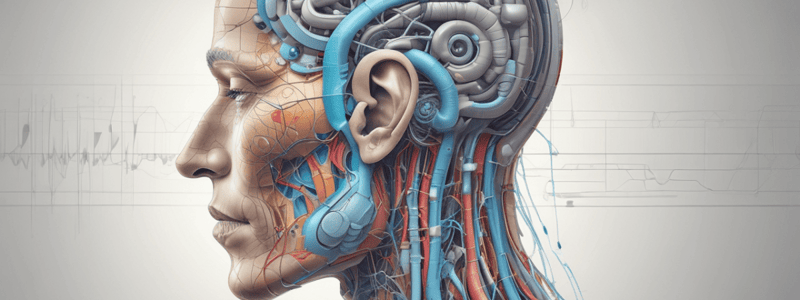Podcast
Questions and Answers
What does the lower curve of an audiogram indicate?
What does the lower curve of an audiogram indicate?
- Pain threshold
- Maximum audible sound
- Faintest sound that can be heard (correct)
- Average hearing range
What is the purpose of using percussion in medicine?
What is the purpose of using percussion in medicine?
- To detect underlying structures by sound (correct)
- To measure blood pressure
- To amplify body sounds
- To examine the eyes
What is the primary component of a stethoscope that acts as an impedance matcher?
What is the primary component of a stethoscope that acts as an impedance matcher?
- Bell (correct)
- Earpieces
- Diaphragm
- Tubing
On what factors does the natural frequency (F_res) of the stethoscope's bell depend?
On what factors does the natural frequency (F_res) of the stethoscope's bell depend?
Which types of percussion sounds can be produced by striking the body surface?
Which types of percussion sounds can be produced by striking the body surface?
What is the function of the diaphragm in a stethoscope?
What is the function of the diaphragm in a stethoscope?
What does the upper curve on an audiogram represent?
What does the upper curve on an audiogram represent?
Which frequency range do heart sounds typically fall into?
Which frequency range do heart sounds typically fall into?
What components are found in modern stethoscopes?
What components are found in modern stethoscopes?
At what frequency is a sound barely audible according to the audiogram?
At what frequency is a sound barely audible according to the audiogram?
Study Notes
Audiogram
- An audiogram displays the faintest sounds that can be heard (hearing threshold) and the loudest sounds that can be heard without pain (pain threshold)
- At 1000Hz, a sound is barely audible
Applications of Audible Sound in Medicine
Percussion
- Percussion involves producing sounds by striking the body surface to detect underlying structures
- There are three types of percussion sounds: resonant, hyper-resonant, and dull
Stethoscope
- A stethoscope is a diagnostic instrument that amplifies sounds made by the body
- Modern stethoscopes consist of a bell, tubing, and earpieces
- The bell serves as an impedance matcher between the body and the air in the tube
- The natural frequency of the bell (Fres) depends on the diameter (d) and tension (T) of the diaphragm: Fres ∝ √(T/d)
- The appropriate bell size and diaphragm tension must be chosen to selectively pick up certain frequency ranges (e.g., low-frequency heart murmurs or high-frequency lung sounds)
Image Descriptions
- Image 1: An audiogram showing the relationship between loudness in dB and frequency in Hz, with three regions: threshold of audibility, threshold of pain, and normal hearing range
- Image 2: A diagram of a doctor using percussion to examine a patient
- Image 3: A stethoscope diagram showing a bell, tubing, and earpieces, with the bell serving as an impedance matcher
- Image 4: A graph showing the relationship between sound intensity (dB) and frequency (Hz), divided into heart sounds and lung sounds, with heart sounds typically lower in frequency than lung sounds
Studying That Suits You
Use AI to generate personalized quizzes and flashcards to suit your learning preferences.
Description
This quiz covers the concept of an audiogram, including the hearing threshold and pain threshold, as well as the applications of audible sound in medicine, such as percussion.




